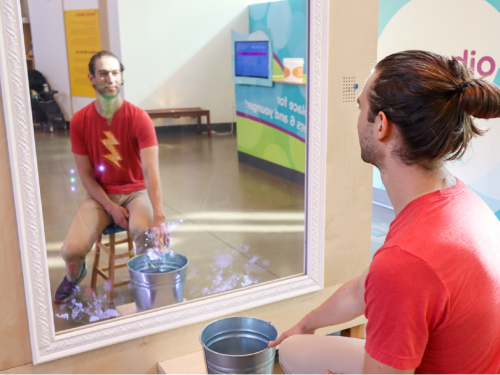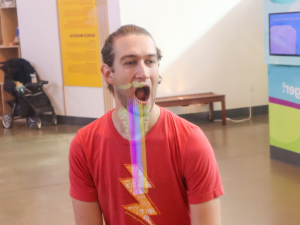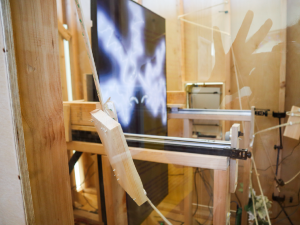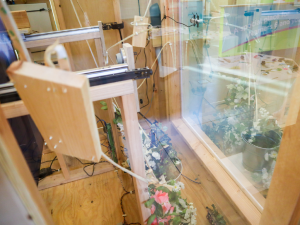Maker in Residence: Tyler Altenhofen
The Maker in Residence program brings creatives with their various experiences to the Scott Family Amazeum for a short-term residency to collaborate with team members in developing new Science, Technology, Engineering, Art, and Math (STEAM) exhibits, public art and performance pieces, and experiences to share with Amazeum guests.

The exhibit: Magic Mirror
A large wooden box with a mirror that reflects exciting special effects on the user's face.
What’s going on
This exhibit uses the Pepper’s Ghost effect to create wonderful illusions. Pepper’s Ghost is the reflection you see when you look at a window or a glass door. Try looking for Pepper’s Ghost in other places!
The Maker: Tyler Altenhofen
When one traditionally thinks of computer programming, we think about buttoned-up and complicated, yet functional code that runs the technology we use every day. Tyler likes to play with how people perceive the world and the different interactions achieved through things like 3D printing and how that can be integrated with programming. Tyler’s computer science background shifts this idea of how technology is continuing to influence the world and its creative mediums.
 When Tyler began his residency he wasn’t sure what to expect, but was excited to open a new chapter in his maker experience. “Going into it I found it was a very exciting and collaborative environment. I learned a lot about how to interact with guests and children, how to design exhibits that are going to last, and how to capture the attention of the people in the museum.”
When Tyler began his residency he wasn’t sure what to expect, but was excited to open a new chapter in his maker experience. “Going into it I found it was a very exciting and collaborative environment. I learned a lot about how to interact with guests and children, how to design exhibits that are going to last, and how to capture the attention of the people in the museum.”
“My project was the Magic Mirror. When you walk up to it, it appears to be a large box with a mirror. When you sit down in front of it, different effects get overlaid on your face. There’s a large monitor behind the mirror that is actuated to move back and forth to create different special effects. So you might get a beard over your face or funny eyebrows, things like that.”
 For Tyler, his most challenging task was the technical side. He had to work through the question of how to integrate all of the different systems that made his exhibit work. “I have 4 or 5 different microcontrollers that are all talking to the main laptop controlling each of them. Each has its own custom-designed communication protocol over serial and controls all the different lights and motors to do all of it in an effective and efficient way.
For Tyler, his most challenging task was the technical side. He had to work through the question of how to integrate all of the different systems that made his exhibit work. “I have 4 or 5 different microcontrollers that are all talking to the main laptop controlling each of them. Each has its own custom-designed communication protocol over serial and controls all the different lights and motors to do all of it in an effective and efficient way.
 One special attribute of this exhibit may not be obvious at first glance when your focus is on the lightning storms and dazzling flowers. “One of the things I think worked out really well in my project was introducing a window.” The Scott Family Amazeum likes to have the functionality and inner workings of its exhibits to be more prevalent and easily accessible so young guests can actually see and be curious about how things work. “When someone is using the exhibit you can actually see all of the different motors actualizing with the lights going off and see everything actually functioning in a very clear way.”
One special attribute of this exhibit may not be obvious at first glance when your focus is on the lightning storms and dazzling flowers. “One of the things I think worked out really well in my project was introducing a window.” The Scott Family Amazeum likes to have the functionality and inner workings of its exhibits to be more prevalent and easily accessible so young guests can actually see and be curious about how things work. “When someone is using the exhibit you can actually see all of the different motors actualizing with the lights going off and see everything actually functioning in a very clear way.”
When an exhibit's inner workings are easily seen and explained, it makes the experience of “making” feel possible and not overwhelming. “Typically robotics is wrapped up in a very sleek, nice case so this is an instance of making a large monitor move around at high speeds that’s just on 2x4s. This gives a good sense of approachability.”







